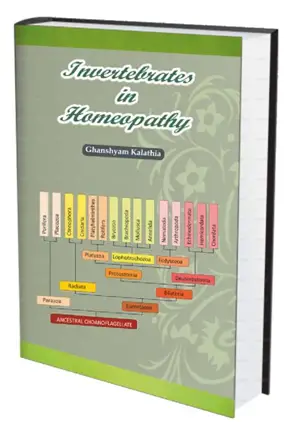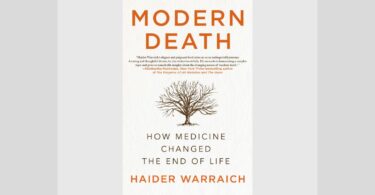Title: Invertebrates in Homeopathy
Printed and published in India
Author and Publisher Dr. Ghanshyam Kalathia
Hard bound
Multi-color book with attractive pictures and charts
Size 6.8/9.5 inches
Pages – 310
Written in extra large fonts

Another jewel in my library
For quite some time I was trying to understand and practice homoeopathy from the kingdom perspective. Before reading this book I used the orthodox method which we’ve been following for the last two centuries.
In the last two decades much was written about kingdom analysis by Dr. Rajan Sankaran, Dr. Jan Scholten, Dr. Nancy Herrick, Dr. Massimo Mangialavori etc. Recently I came across this wonderful text, Invertebrates In Homoeopathy by my teacher and esteemed friend Dr. Ghanshyam Kalathia.
Understanding invertebrates is really a cumbersome task. This is the area where we find so many creatures with lots of variations. I believe Dr. Kalathia’s book is a huge contribution to the world of homoeopathy.
The book begins with the basic explanations of taxonomical classification and slowly takes us to the realm of invertebrates, followed by essential themes. His narration of the evolution and human developmental stages was derived from Dr. Michal Yakir and Dr. Mahesh Gandhi.
The basic invertebrate themes are followed by the marine themes and then the parasite themes. In every chapter he finishes with a summary which is very convenient for the reader.
There is a small chapter about the guide to selecting an invertebrate remedy which he called The Four Dimensional Mapping. Before this, whenever I thought of making a prescription from this arena, I would limit myself to a few options y like some molluscs or arachnida or very few insects. But this book gives a wonderful and easy understanding of the entire invertebrate realm.
Next comes the individual narration of each phylum. Brief but lucid taxonomic information of each phylum is followed by general themes of that particular phylum from the evolutionary and individualistic point of view.
Then comes a description of individual remedies of each and every remedy belonging to that particular phylum. It’s really a delightful feast for the enthusiastic reader. Here we have the entire spectrum of each remedy with its thematic, personality, characteristic information which is explained by the help of rubrics from the repertory whenever needed, and followed by cases.
Once you read and understand the cases, it will give you a beautiful spectrum of that remedy and the understanding in general. The cases of Badiaga and Corallium Rubrum are really eye-openers.
Every case will give you the exact essence of that particular remedy. One more excellent feature is, that at the end of every phylum he gives the affinities along with the relationship to other families and kingdoms like bryozoa in relation with porifera, platyhelminthes, brachiopods and mollusks, which is very useful in practice to make quick differentiation. The language is very simple for the reader and the style of arrangement is very clear.
Here I would like to mention one example. Weak and fragile sponge’s main fear is to be uprooted or not grounded enough. This is how we see their vulnerability. Their need to be on the ground is their prime focus in life, because once they uproot, they vanish to the shore and die. I consider this a must read for every serious homoeopath.






Where can I buy a copy NOW, direct from India or in UK or EU? Thanks
I’m not impressed by this Kingdom or taxonomical classification of remedies.
The remedies irrespective of any Kingdom or other biological classifications, are all related to one another. They are all mutually related except in one or two main differences which form the basis of their differentiation from one another. For example lachesis is different from nitric acid in that the former has aggravation from sleep whereas the latter has aggravation that prevent sleep. In most other respects they are similar. But one of them is from animal kingdom and the other mineral.
We are concerned with their dissimilarities rather than similarities for the purpose of prescription. Similarities in the symptomatologies of remedies belonging to a particular biological class like “invertebrates”, or any other is no more important than the similarities between ANY two remedies.
This is for a special reason peculiar to particle physics or Quantum mechanics which governs the behaviour of submicrosopic particles like homeopathic ultra high dilutions.
We can see that arsenic alb has love of water ( drinking frequently ) and belladonna has dread of drinking, so that transition from one to the other is smooth. This phenomenon is common to any other pair of remedies. There’s no Kingdom influence in such remedy relationships.
Such classification on the basis of Kingdom or any other taxonomy, though seemingly scientific, is only unscientific as far as homeopathy is concerned. An unwanted or unhealthy development in homeopathy.
Skeptics would be quick to denounce this as rhetoric and ridicule the bankruptcy of homeopathic theorists.
The special feature of such spectral behaviour like homeopathic remedies is essentially orthogonal relationship, which fascilitates easy transition called rotational transformations where every element of the spectrum is only slightly dissimilar to one another ( and of course similar in all other observables)
Classifications scientific to biology or chemistry are “unscientific” when it comes to
Homeopathy which essentially belongs to the domain of Quantum physics or particle physics.